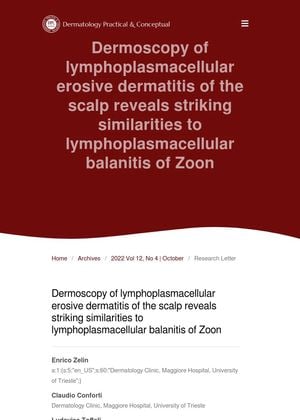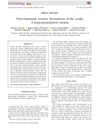Dermoscopy of Lymphoplasmacellular Erosive Dermatitis of the Scalp and Its Similarities to Lymphoplasmacellular Balanitis of Zoon
October 2022
in “
Dermatology practical & conceptual
”

TLDR Scalp skin condition LEDS has similar features to Zoon's balanitis, a mucosal skin disorder.
The document discusses a case series that highlights the challenges in diagnosing eroded lesions and crusts on the scalp, particularly distinguishing between neoplastic diseases and Lymphoplasmacellular Erosive Dermatitis of the Scalp (LEDS). The study suggests that LEDS shares many characteristics with Erosive Pustular Dermatosis of the Scalp (EPDS), including advanced age, actinic damage, and history of previous trauma/surgery. However, LEDS presents a unique dermoscopic pattern, characterized by an orange structureless background with focused linear vessels, which is linked to idiopathic lymphoplasmacellular mucositis-dermatitis (ILPMD). This pattern is also seen in Zoon balanitis/vulvitis, a disorder that affects mucosal areas. The study concludes that while LEDS could be seen as a variant of EPDS, its distinctive dermoscopic and histological features suggest it may also be categorized within the spectrum of chronic idiopathic lymphoplasmacellular dermatitis. Further research is needed to better define this entity.

